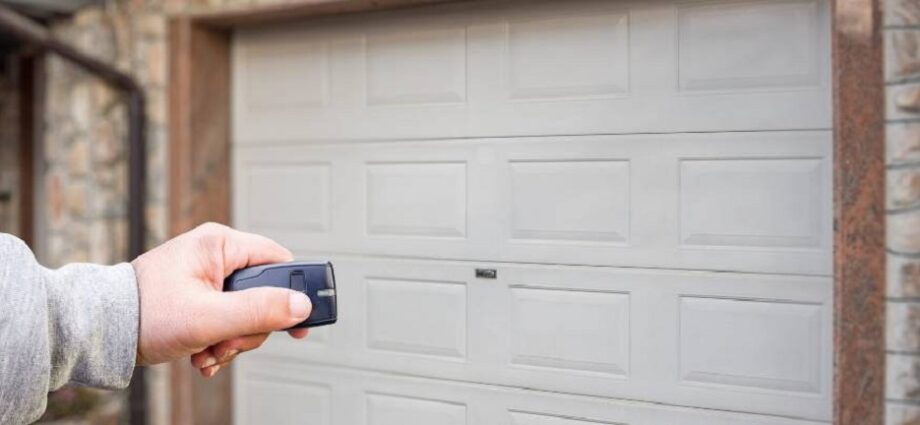Garage doors, when dented and damaged, can give an unappealing look to your home and decrease its visual appeal. However, there are several efficient techniques available for removing dents from garage doors and restoring their appearance. With some essential tools and supplies, garage door dent repair tasks can be easily performed.
Assessing the Damage

The first step in garage door dent repair is assessing the damage. Small dings and minor dents may be fixable with just a few tools, while larger dents or those that affect the door’s structural integrity may require professional repair.
When examining dents, look at the door’s size, depth, and location. Shallow dings toward the edges can often be smoothed out, while deep creases or dents near the center bracket may need professional work. Check that the dent hasn’t caused any sharp edges or points that could catch and tear.
Run your hand over the dented area to feel if the metal has been stretched or warped. Look to see if the dent has caused any cracks or fractures in the surface. Carefully inspect both sides of the door and check the window panels if applicable.
DIY dent removal is likely possible if the dent is minor and has not damaged the underlying structure. For anything more serious, contact a professional garage door technician.
DIY Dent Removal Techniques and Tools
Here are some standard techniques and tools used for removing minor dents from garage doors:
Dry Ice
Dry ice can be highly effective for popping minor dings and dents out sheet metal garage doors. To use it:
- Obtain a piece of dry ice from a local grocery store or supplier. It’s best to wear insulated gloves when handling dry ice.
- Place the dry ice over the dented area for 30 seconds to 1 minute. You’ll see frost developing on the metal.
- After frost forms, gently tap the metal from the backside using a rubber mallet or hammer with a wood block. Strike around the edges of the dent first, then work toward the center.
- The rapid cooling from the dry ice causes the metal to contract, allowing you to push the dent out smoothly.
- Repeat as needed until the dent is removed. Warm water can help thaw any stubborn spots.
Hot Water or Heat Gun
Another DIY dent removal method is using heat. The steps are:
- Bring a pot of water to a boil on the stove. Or use a heat gun if you have one available.
- Place a wet rag over the dented area and hold it there for 30-60 seconds. This heats and expands the metal.
- Use a rubber mallet and wood block to gently hammer out the dent while the area is warm and expanded.
- Reheat and repeat as necessary until the damaged area is smooth.
Suction Cup Dent Puller
- Purchase a suction cup dent-pulling kit from an auto parts store. This uses hydraulic pressure to pull dents.
- Clean the area thoroughly and attach the suction cup centered over the dent.
- Operate the puller per the manufacturer’s directions to draw the metal back into shape slowly.
- Release pressure and reposition the cup to work the dent from all angles.
Rubber Plunger
For tiny dings, a standard household plunger can sometimes do the trick:
- Place a piece of wood inside the garage door behind the dent. This provides backing support when pulling.
- Wet the plunger head and position it centered over the damaged area. Apply firm pressure and engage the plunger with quick pumping motions to draw out minor dings.
- Work your way around the periphery of the dent to slowly massage it out.
- The flexible rubber allows you to contour the plunger to the shape of the dent.
Bondo or Spackle
For minor dents that refuse to come out, you can fill them with body filler products:
- Thoroughly clean and dry the dented area for the filler to adhere correctly.
- Apply lightweight filler such as Bondo or Spackle using a putty knife. Press firmly into the dent to fill the damaged spot.
- Smooth and level the filler using gentle sanding. Avoid over-sanding.
- Apply primer and paint to match the surrounding garage door surface. Blend and touch up paint as needed.
Proper prep work is crucial for effective filler repairs. Take your time and allow ample drying time before sanding and painting.
Hiring a Garage Door Technician for Dent Repair
Many garage door service companies offer professional dent removal services for dents that are too large, deep, or complex for DIY repair methods. Technicians have commercial equipment to take dents out while avoiding further damage.
When hiring a pro, look for companies that:
- Offer free onsite estimates so you know the expected costs.
- Have technicians specially trained in metal straightening and finishing.
- Use modern dent removal tools like power welders and pull rods.
- It will match your existing door color for a consistent appearance.
- Provide warranties on labor for dent services.
Reputable garage door companies often charge around $100 to $300 to remove medium dents, with higher prices for more extensive repairs. New door panel sections may be needed for severe damage.
Compare multiple estimates and check reviews before choosing a dent repair company. Confirm they can match your door brand and color if doing touch-up painting. This ensures the best results.
Steps for Repairing Common Dent Types
The specific techniques used to remove dents depend on the damage’s size, shape, and location. Here are some steps for fixing the most common garage door dent types:
Middle Panel Dents
- Assess dent depth – deep dents in the middle panel may need professional repair.
- Place dry ice or hot water rag over the damaged area to expand the metal.
- Put a wooden block inside for backing support.
- Use a rubber mallet and knock it down from the center outward.
- Check that the panel can still move freely without catching.
Low Corner Dents
- Low dents are often from car bumpers – assess the depth and metal stretching.
- Use a heat gun or boiling water to expand the metal if accessible.
- Push out from behind using a wood block and hammer if able to reach from inside.
- Use fillers like Bondo if unable to push the dent out fully. Sand and repaint for a smooth finish.
Top Panel Dents
- Use a step ladder to reach high dents near the top of the door—exercise caution.
- Apply dry ice to the dented section to contract the metal.
- Gently hammer outward from the inside using a rubber mallet.
- Fill any remaining shallow dents with spackle or Bondo and sand smooth.
Window Panel Dents
- Avoid striking the window glass – cover it with cardboard when hammering.
- Heat the dented metal with a hair dryer or heat gun to expand it.
- Place a wood block inside and tap out the dent carefully from the center.
- Use window caulk to fill tiny dings in the window trim.
Garage Door Frame Dents
- Assess that the frame is not bent – this requires professional repair.
- Use a heat gun to warm the dented area of the frame.
- Push outward with a wood block and hammer from the inside.
- Use body filler in the corners if unable to push the dent flush.
Take care when hammering near window glass panels or garage door frames. Avoid damaging the surrounding areas.
Tips for Preventing Dents
While quality garage door materials are dent-resistant, damage can still occur over the years. Here are some tips to help avoid dents and dings:
- Install rubber spacers or wall guards along the inside of the garage. These act as bumpers when vehicles pull in.
- Adjust the travel height so vehicles don’t strike the door when opening and closing. Allow 2-3 inches of clearance.
- Open the door fully before pulling vehicles in or out of the garage. This avoids nicking the corners.
- Park vehicles fully inside, away from the door opening. Consider extending your driveway length.
- Remind family members and guests to open the door fully before passing through. Watch for pets and kids near the door.
- Keep the garage door tracks clean and lubricated so the panels can move freely without catching.
- Consider upgrading to a steel door for maximum dent resistance if you have an older wooden door.
Being proactive about garage door safety and maintenance can help prevent annoying dents and dings over time. But despite your best efforts, accidents happen. Use the dent removal techniques outlined here to keep your door looking pristine.
FAQs
1. Is it OK to pound out garage door dents from the outside?
Only tap out dents from the inside with support behind the damaged area. Striking dents from the outside can warp and stretch the metal and damage the exterior finish. Always hammer outward from the inside of the door.
2. What is the easiest way to fix a garage door dent?
A plunger or suction cup dent puller is most accessible for minor dings. Center it over the damage and gently apply pumping motions or hydraulic pressure to push the dent outward. Dry ice and heat also work well for contracting and expanding minor dents to pop them out.
3. When should you call a pro for garage door dent repair?
Contact a professional garage door technician if the dent is enormous, has cracked or warped the metal, or has damaged the underlying structure. Severe frame damage also requires a pro repair. Dents near windows, edges, and garage door brackets often need expertise.
4. Can I use car body filler to fix dents in a garage door?
Yes, lightweight body filler (Bondo) or even wood spackle works to fill minor garage door dents that cannot be pushed out. Ensure the area is clean before applying, and give ample drying time. Sand smooth before painting to match the door.
5. Will home insurance cover garage door dent repair?
It depends on your policy, but common dents and dings damage are often excluded as regular wear and tear. More extensive damage from a vehicle impact may be covered under collision coverage minus your deductible amount. Check with your insurance provider.
Conclusion
There are various practical garage door dent repair techniques using standard household tools. Carefully assess the type and extent of damage to determine if it’s within your DIY capabilities or requires calling a professional. With patience, the correct methods, and proper safety precautions, you can repair a broken garage door spring, working out dings and restoring your garage door to like-new condition. Taking steps to garage door dent repair is also advised. Keep this overview handy for completing garage door dent repair tasks.












